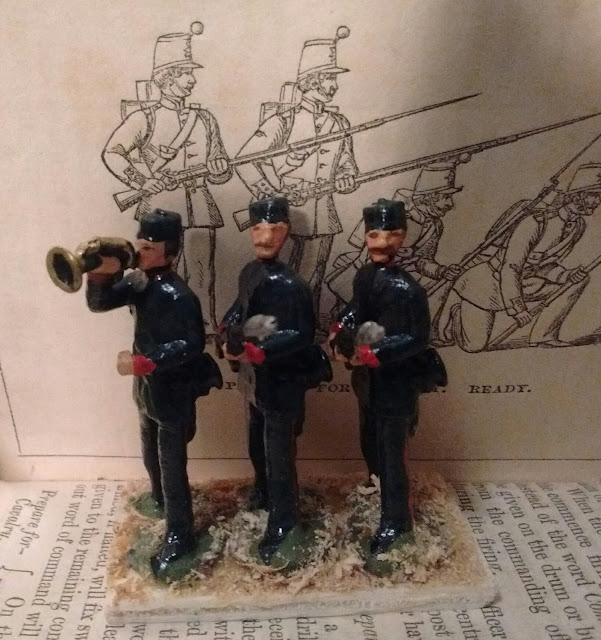The 2nd new unit is now painted up as Victoria Rifles c 1860 and the 3rd unit is cast and waiting to be deflashed and primed. They can be seen below standing in front of their bible, an 1861 manual that I picked up at an antique book stall in Kingston during the summer of '76 when I accompanied Doc Ruddy to a conference of military museum curators and historians. (I was cadet curator of the Fort St Jean museum under him). The manual covers everything from basic drill, to how to teach yourself to estimate distances and the room needed to deploy X number of men, to battalion tactics, to manouevering brigades and divisions and more.
I was expecting to play a test game today but as I was starting to set up yesterday I realized that I've had enough test games with motley collections of various stand-in figures as I hesitate over periods and rules options. My attempts to avoid focusing on the area of greatest interest in favour of trying to do a bit of all main interests have (predictably but not inevitably) failed and its time to just accept and get on with it.
(This is not to say that I have just 1 period/collection now, merely that all those outside the mid 19thC era are relegated to secondary with as many as possible being of the "game in a box" sort.
Therefore, I took the rest of yesterday's hobbyroom time to paint up more figures and spent part of my pack (ie family) time browsing old blog posts (aided by the occasional nose or paw). As suspected, every one of my recent rules ideas, issues and options has already been thought of within the last 3 years and put to the test. A few ideas and options have been rejected, others remain as valid options of the "you pays your money and takes your choice" sort.
 |
| The Volunteer "Brigade". Should be ready by Monday. |
The 2nd issue resolves around the questions of "what is a unit?", "can it be split mid game or spread across multiple grid squares and later be reformed?" and "do unit formations need to be shown during this era or can they assumed?" Once again the answers are "it depends what you want to do". To give a basic example, a battalion could vary from say 300 up to 750 or more men (conveniently rounded numbers) and thus have a frontage between 100 up to 250 yards in line. By 1860 any where from 1/2 to none of it might be deployed as skirmishers and supports up to 400 yards in front of it. The weapon ranges I use suggest an average of 150 yds per square give or take 50 so a battalion could occupy anywhere from 1 square to an area 2 squares wide and 3 deep! Do I want to go there? Absolutely not.
My answer becomes a practical game one with some historical justification. Firstly, large battalions were sometimes split or small ones used together so standard units are quite acceptable to me. Secondly while the theory was that each battalion would provide its own skirmishers and supports and that the skirmishers would rejoin the rest of the battalion when the armies closed, memoirs and the like suggest that the skirmishers would often not rejoin till the fight was over and it seems that it was not uncommon for one battalion to be designated as providing the skirmish line and close supports leaving the rest of the brigade formed. Since I want permanent "units" for campaign and narrative purposes, I am going back to the way the square brigadier handled things stretching back towards MacDuff. The basic infantry unit will be a "company" (2 stands of 3 figures but anything will do). In theory 4 of these will form a "Regiment" for organizational and historical purposes but any number of them plus a "General" will form a Brigade. However at the start of the game or upon arrival as reinforcements, any infantry company may be replaced by 2 units of Skirmishers. These may not be reformed during the game. The infantry companies can be stacked 2 to a square in clear terrain.
If all goes smoothly, I will spend tomorrow working on figures and will play a small game on Sunday. Oberberg and Atlantican native forces aren't really ready to take the field yet so the game will again be an Oberhilse vs Faraway clash.


Bugler conversion works a treat.
ReplyDeleteThanks, I like him.
DeleteSplendid Volunteer Brigade Ross - well done indeed! I assume the figures are 40mm- or could I be wrong and they are 54mm? Regards. KEV.
ReplyDeleteThanks Kev, yes 40mm
DeleteThat bugler is excellent. Nice work Ross.
ReplyDeleteBugler's good - did you turn his head a bit as well? Apart from the position of his feet, he's not an obvious relative of his companions.
ReplyDeleteYes, I made a shallow slice around the neck then gently twisted it and filled back in with glue. There is the small matter of the left hand clenched at waist level which with the feet position is rather more like Digby in Beau Geste than any drill book position for a bugler but I like 'im and he is a young volunteer after all.
Delete